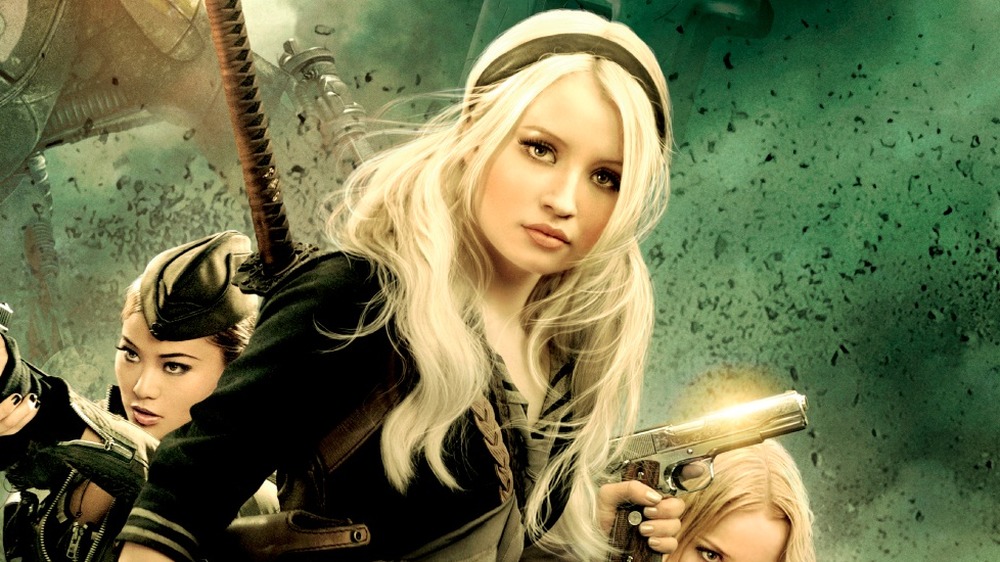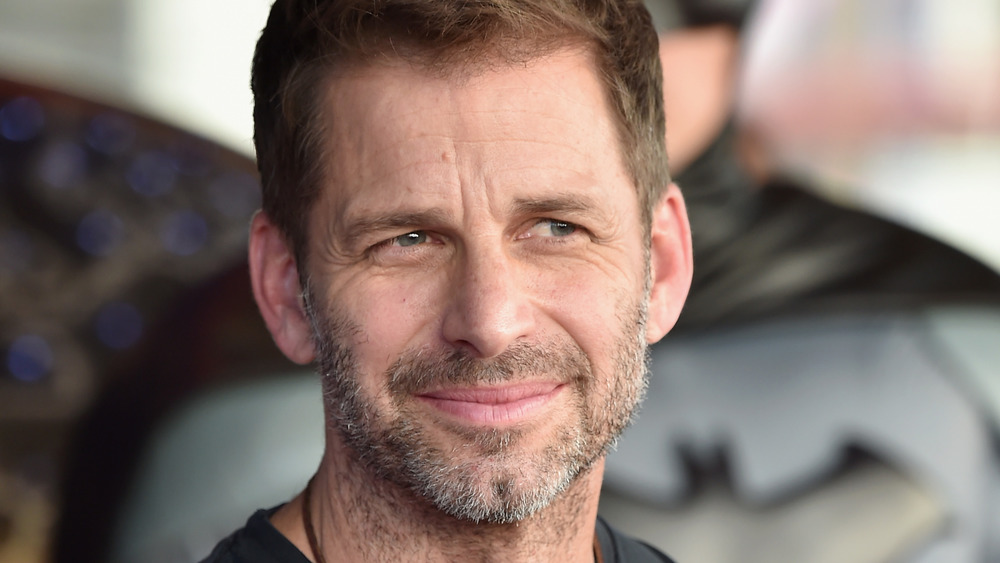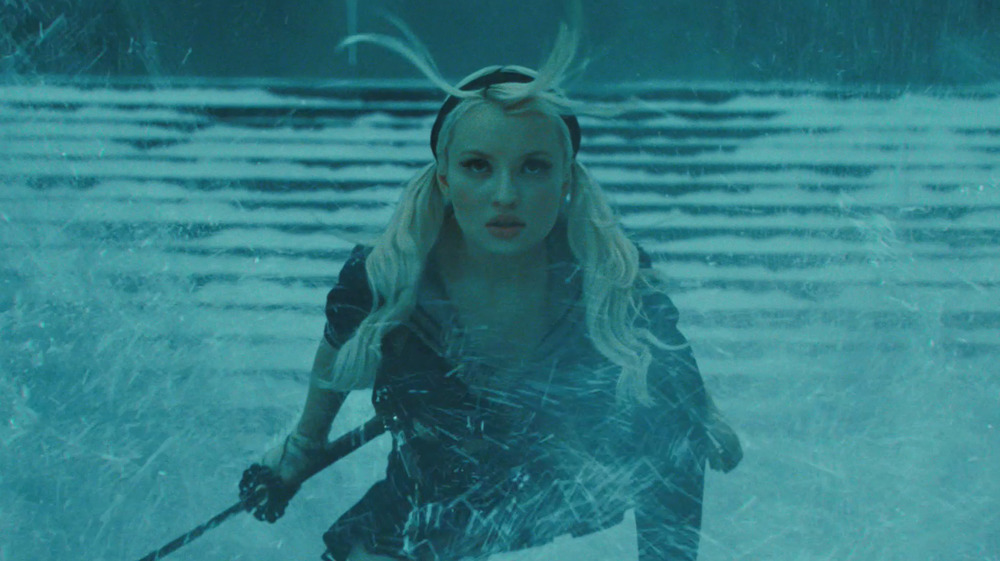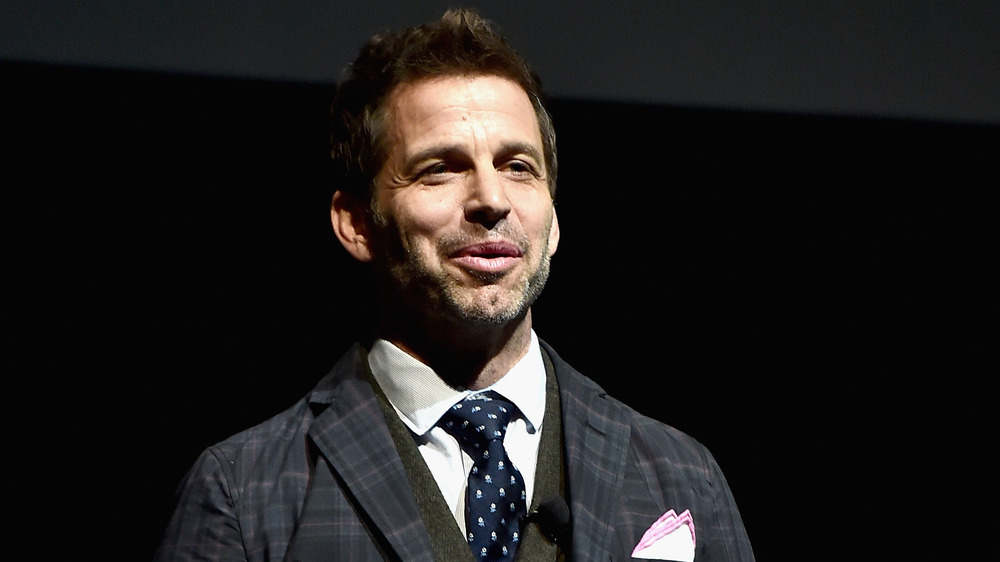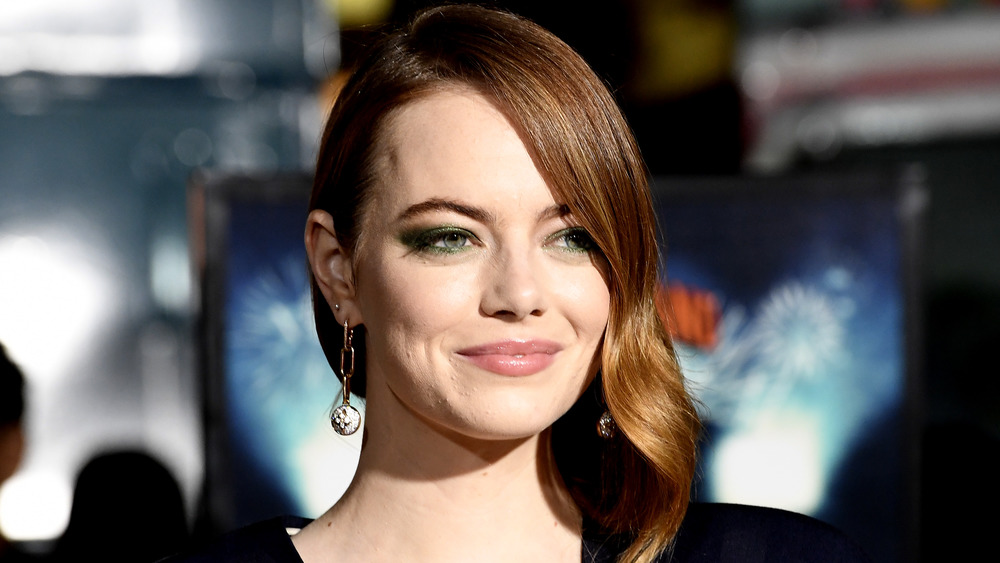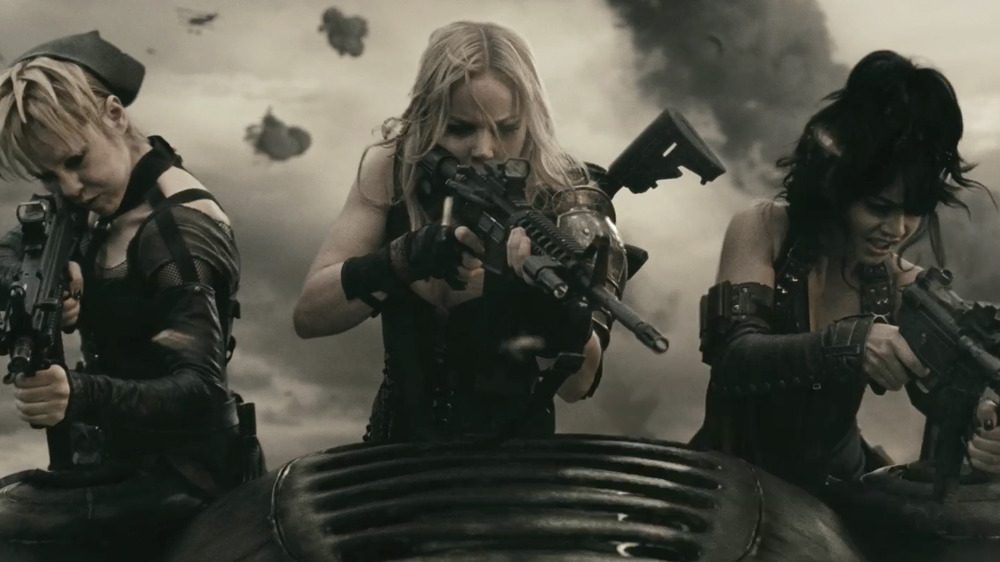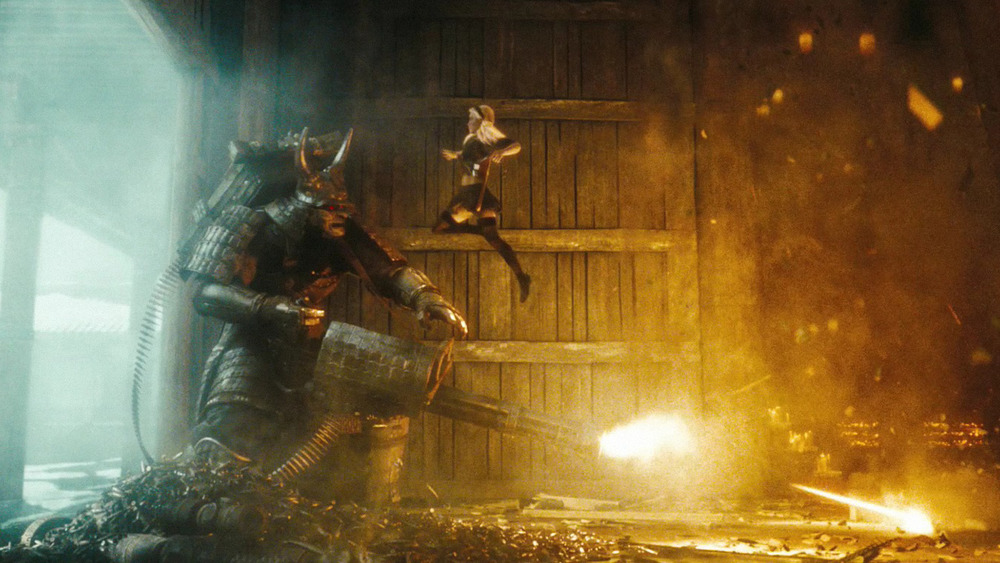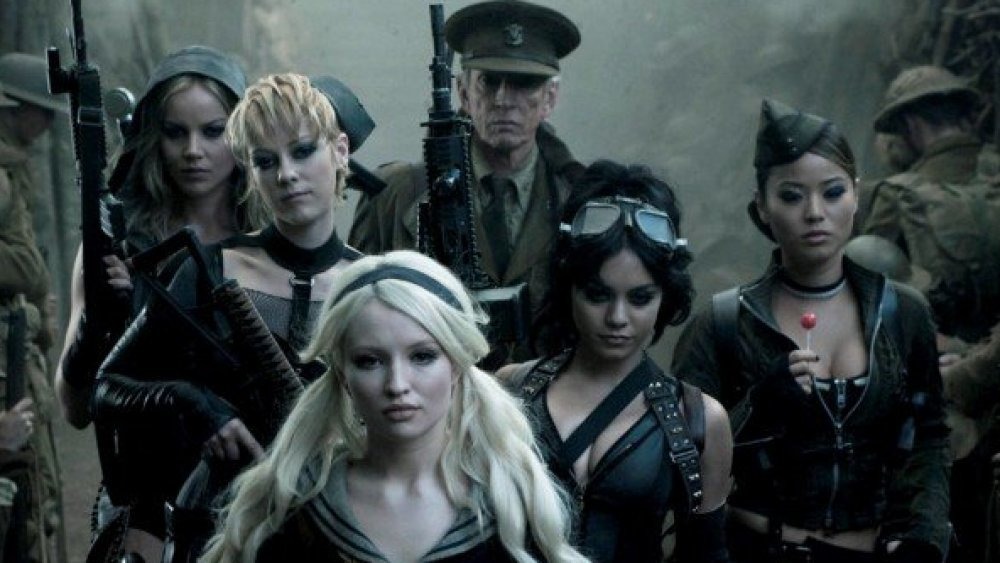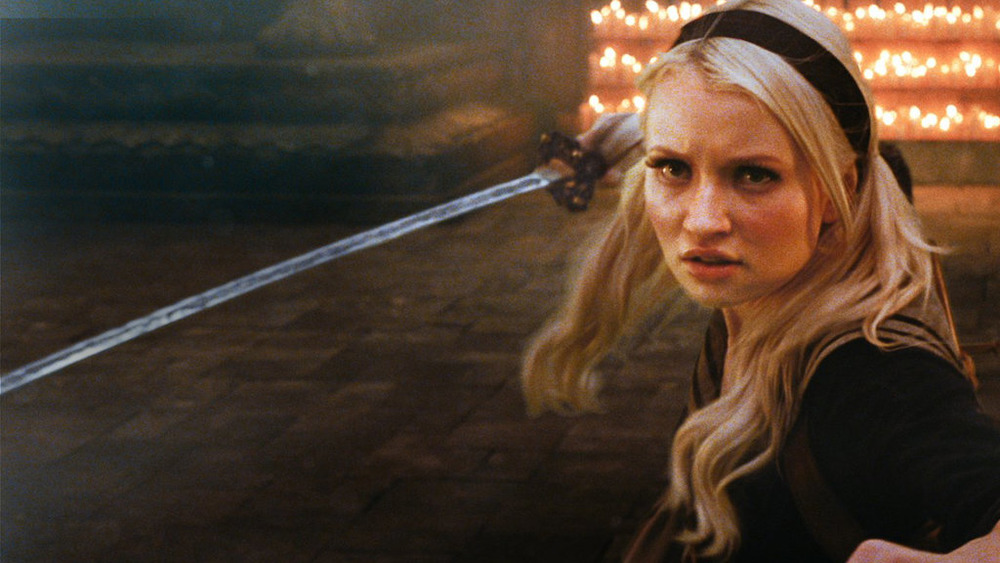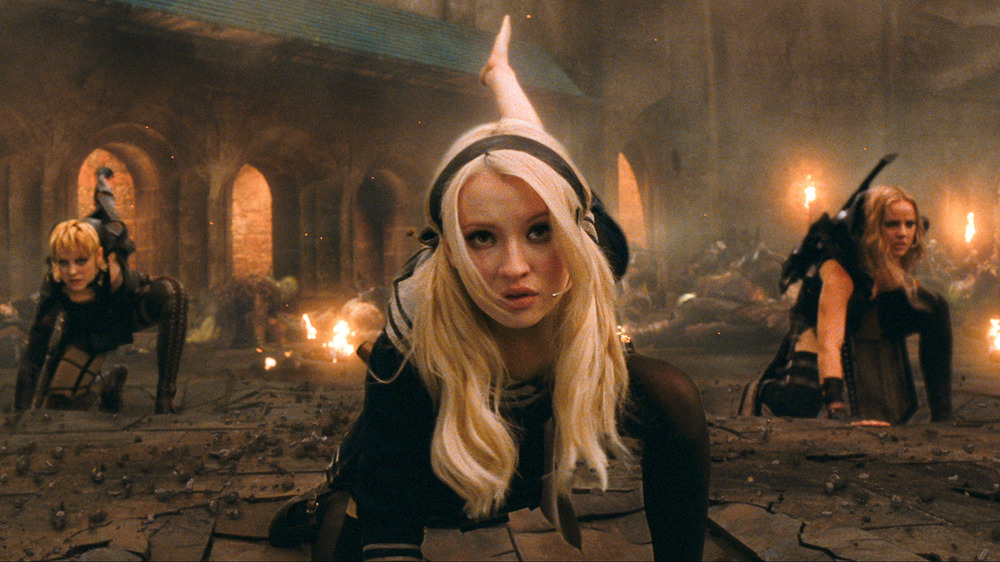The Untold Truth Of Sucker Punch
"It's everyone of us who holds power over the world we create."
Those words kick off Sucker Punch, the fifth directorial effort from Zack Snyder. This movie tells the story of Babydoll (Emily Browning), a young woman who, after claiming her abusive stepdad killed her younger sister, is put into an insane asylum along with a gaggle of other girls. While trapped in there under the watch of cruel figures like Blue Jones (Oscar Isaac), Babydoll and the other inmates begin planning an escape. Their preparations for this getaway, as well as their coping processes inside the asylum, are filtered through elaborate action-fantasy sequences that span a wide variety of genres. There's also lots of musical numbers, bleak storytelling turns, and ... bold costume choices.
Snyder's first completely original property, Sucker Punch opened in movie theaters in March 2011 and proved to be a box office disappointment. With a $90 million sum, it's Snyder's lowest-grossing movie at the worldwide box office and garnered largely negative reviews. Despite its underwhelming theatrical run, Sucker Punch has continued to generate plenty of conversation in the pop culture consciousness. Whether you like it or hate it, Snyder's Sucker Punch is an ambitious work that offers lots to talk about, particularly when it comes to the elements (like themes, casting, and visual influences) that defined one of the more divisive blockbusters of the 2010s.
Sucker Punch was a breakthrough for Snyder's production company
Two months prior to the release of his film 300, director Zack Snyder struck a first-look deal between 300 distributor Warner Bros. (WB) and his own production company, Cruel and Unusual Films (now called The Stone Quarry). Considering WB had never released a film from Snyder prior to 300, committing to him for the long haul was a bold move, though one WB brass felt was well-warranted. "Zack is an incredible storyteller — he's got vision and a style all his own," then Warner Bros. production president Jeff Robinov said at the time of the deal. Robinov's confidence in the filmmaker turned out to be well-placed when 300 hit theaters and proceeded to score the biggest opening weekend ever for a March release.
Just a few days before 300's opening day, the first title in WB and Cruel and Unusual's partnership was revealed. The project was an original endeavor entitled Sucker Punch. Though Watchmen would end up getting released before it, the announcement of Sucker Punch marked Snyder's first major foray into a post-300 world. Having proven himself with his Spartans epic, Snyder was now looking to launch an original idea through his own production company, which had the backing of one of the biggest movie distributors on the planet. Though its eventual box office haul fell short of his other movies, Sucker Punch would still prove to be an important stepping stone in the careers of both Snyder and Cruel and Unusual Films.
It was supposed to be rated R
For his first three movies, Zack Snyder worked in the confines of an R rating. Dawn of the Dead, 300, and Watchmen all flaunted their restrictive ratings with an avalanche of grisly violence and buckets of gore. Initially, it appeared that Sucker Punch was going to follow this trend. Outlets like Entertainment Weekly and SlashFilm described the project as being "R-rated". On paper, the film's plot, which involves sexual assault and violent showdowns against everything from zombies to samurai, would certainly warrant that rating.
However, the theatrical cut of Sucker Punch ended up scoring a PG-13 rating with the MPAA, a first for a live-action Zack Snyder film. How did Sucker Punch go from being R-rated to PG-13? Well, it wasn't an easy transition. While promoting the film's home video release, it was revealed that studio mandates necessitated a PG-13 rating, and producer Deborah Snyder noted that Sucker Punch had to be sent to the MPAA board "five times" before it secured a PG-13 rating.
Among the moments cut were a sex scene between Emily Browning and Jon Hamm's characters, as well as further moments emphasizing the darkness of the brothel that Babydoll and the other lead characters were trapped in. In the end, the more inclusive MPAA rating didn't do Sucker Punch any favors at the box office. However, for those craving the version of Sucker Punch that was originally promised, an extended R-rated cut did end up on the film's home video release.
Snyder was driven by the power of imagination
Zack Snyder's movies have never been bound by the rules of reality. Zombies, a gigantic blue god, and armor-clad owls charging into battle have been common sights in his projects. But for Sucker Punch, Snyder wanted to take his own stylized visions to the next level. For this project, multiple sequences would take place in the imagination of the in-universe characters, freeing him from being shackled by any of the rules of realities.
Snyder's excitement over that concept was reflected in some of his earliest comments on the film, where he described Sucker Punch by saying, "I wanted to design a thing where there's no limits on me at all, and that's a difficult thing. And I still want it to be a cool story and not just like a video game where you're just loose and going nuts. Personally, there are moments I like in movies that are larger than life. That's what I was trying to say. How can I do this? How can I get that moment over and over?"
Imagination was fueling Snyder's process for Sucker Punch rather than the tangible, an element reinforced by how Snyder compared the project to Lewis Carroll's children's book Alice in Wonderland. Alice's adventures tended to defy rational thought while incorporating scenarios that could best be described as "trippy." For his fourth live-action film, Zack Snyder wanted to channel that energy and make Sucker Punch an action movie that was as confounding as it was exhilarating.
Amanda Seyfried was supposed to be the lead
The casting process for Sucker Punch wasn't an easy one, particularly for the lead character of Babydoll. The first choice for this role was Amanda Seyfried, who, at the time, was becoming a breakout star. Fresh off the box office sensation Mamma Mia!, Seyfried was in high demand for a wide assortment of projects, including Sucker Punch. Snyder publicly expressed excitement for Seyfried taking on the role, which would've been the actress's first foray into the world of action movies. However, at this time, Snyder reflected that it wasn't going to be easy to secure Seyfried due to her busy schedule. "I don't know," Snyder said in February 2009 about Seyfried being cast in Sucker Punch. "I mean, she's got some other obligations, and we're just trying to figure that out."
In the end, this casting never came to fruition. Seyfried's "other obligations" won out against taking on the part of Babydoll. Specifically, Seyfried's commitments to the HBO TV show Big Love ensured that she wouldn't be available to shoot Sucker Punch. Though a significant setback for the project, it wasn't long before a new performer took on the role of Babydoll. Emily Browning was eventually selected for the part in one of her first leading roles as an adult actress. She may not have been the original pick for the production, but Browning ended up sticking with Sucker Punch and even had a positive experience portraying Babydoll.
Emma Stone was offered the role of Amber
By early 2009, Emma Stone had only appeared in a handful of movies, but she was already making a splash. Her supporting performances in comedies like Superbad and The House Bunny had left a major impression on audiences. Soon after, she expanded into leading roles with titles like Zombieland and Easy A. For a hot moment, though, it also looked like one of Stone's early film roles would entail her leaping into the world of action filmmaking with a supporting role in Sucker Punch. By March 2009, it was reported that Stone, alongside performers like Abbie Cornish and Vanessa Hudgens, was in talks to appear in Sucker Punch's supporting cast, and she was being courted for the role of Amber.
But while Cornish and Hudgens ended up being a part of Sucker Punch, Stone did not. The actress was unable to appear due to scheduling conflicts with another project. With Emma Stone gone, Snyder and company opted to cast Jamie Chung in the role of Amber, instead. While Stone had to sit out Sucker Punch, she wouldn't be sitting out action blockbusters forever. Shortly after Zombieland and Easy A turned out to be hits, Stone would go on to make her first foray into action filmmaking with the 2012 tentpole The Amazing Spider-Man.
Sucker Punch was supposed to be in 3D
In the wake of Avatar's enormous 3D-buoyed success in December 2009, it was inevitable that imitators would emerge. Every Hollywood studio began to convert their titles into digital 3D, including Warner Bros., the outfit behind the infamously rushed digital 3D conversion job on Clash of the Titans. In March 2010, Warner Bros. announced Sucker Punch would be one of a number of upcoming tentpoles from the studio to be converted in digital 3D.
This decision apparently didn't emanate directly from Zack Snyder, who later expressed hesitance about the idea given that Sucker Punch wasn't filmed in 3D. "I'm not going to [convert the film to 3D] if we don't have the time to really be meticulous with it," Snyder said in a July 2010 interview. "It's such an awesome piece of work and everyone's worked so hard to make it awesome, so I don't want to screw it up with bad 3D." By that fall, Snyder confirmed that his reluctance to work with the format had won out over WB's wishes. "We didn't think it would live up to our expectations. So we talked to the studio (Warner Bros) and said, 'Listen, the film is beautiful and very designed to begin with, we don't want to ruin it,'" Snyder explained to Digital Spy. "Too many films are jumping on the 3D bandwagon, and we can't be one of them."
Japanese design elements influenced the visuals
The numerous dream sequences of Sucker Punch display a variety of influences, ranging from World War II films to futuristic sci-fi fare like Blade Runner to stylized musicals like Moulin Rouge! But one critical influence across the entire film is the Japanese design element, which figures prominently into several sequences. This is made apparent in the film's first big set piece, which involves a Japanese pagoda and a gigantic samurai. A later set piece was described by Comingsoon.net as coming directly from "the world of anime as it involves an alien world and a bullet train ... guarded by high-tech robots."
The visual details from Japanese culture that Sucker Punch's utilizes are of a stylized nature and make for an appropriately distinct contrast to the gruesome asylum that the lead girls are trapped in. It also allows Snyder to indulge in his own pop culture affinities, given his love for animated Japanese films such as Ramayana. The execution of these influences within Sucker Punch, though, has drawn mixed responses, with one piece of film academia outright criticizing the film for continuing an "essentialized and overly simplified view of Japan" that reverberates throughout American cinema. Responses to this design influence may be varied, but Sucker Punch's enormous amount of affection for elements of Japanese culture is undeniable.
The meaning of Sucker Punch's title
The title of Sucker Punch, like many elements of the film, is a mystery. There isn't a point where a character says, "We're some kind of sucker punch," nor are there any objects or characters named after the phrase. That means it's up to Snyder and the film's cast to explain the meaning, which has resulted in varying interpretations.
Lead actress Abbie Cornish explained her take (via Digital Spy) on the title as, "Sucker punch is this idea of taking an unexpected blow. A lot of the girls are totally unprepared for what's about to happen to them. [Babydoll] changes their whole perception of freedom, of hope, of escapism. And so their ways of life are challenged, they're sucker-punched with this whole idea of freedom."
Snyder, meanwhile, feels the meaning is hidden within the film's social commentary. "It's like a mechanism in the film that kind of brings us back into reality, I think. But I think, on the other hand, because the movie is a slight indictment –- it talks about geek culture and pop culture," Snyder said (via ComicBookMovie.com), "it's also a sucker punch because I kind of designed it that you go to this movie for entertainment, and you get a little bit f****d up by it, hopefully."
The importance of music in Sucker Punch
Much like in Zack Snyder's Watchmen, music plays a pivotal role throughout Sucker Punch. An assortment of tunes are used as a way in a manner more reminiscent of traditional musicals than a conventional action picture. "I thought it'd be cool to use this musical number as the spine of the movie, the spine of an action sequence, and then getting in and out of it would be, like, the music would start and that would draw us in," Snyder explained to MTV. "That would be the mechanism for the fantasy to begin, and when the music ended, that would be the mechanism for it ending."
The songs used in Sucker Punch aren't original tracks. Instead, Snyder and company employed a variety of famous songs from artists ranging from Bjork to Queen to the Beatles. It's a bold choice for any action blockbuster, let alone one coming out in a pre-Guardians of the Galaxy world. However, Snyder originally planned to take the film's musical tendencies even further than just needle drops.
Sucker Punch was supposed to conclude with a bleak alternate ending that wrung much of its downbeat nature out of a musical performance. Snyder has detailed (via Film School Rejects) that this conclusion saw a lobotomized Babydoll closing out the film by singing a rendition of O-o-h Child on a stage. In other words, Sucker Punch was originally set to conclude with its two most important elements — the perspective of Babydoll and music.
Sucker Punch's commentary on male geek culture
The fantasy sequences in Sucker Punch filter the film's lead characters through a heavily sexualized lens. Babydoll imagines her asylum home as being a brothel where she and her friends perform sensual dances for clients. The action scenes, meanwhile, see the characters heading into battle in tight and scantily clad outfits emphasizing exposed midriffs and cleavage. Snyder's intent with Sucker Punch was to challenge the very moviegoers who may be titillated by this imagery. "I'm always shocked that it was so badly misunderstood. I always said that it was a commentary on sexism and geek culture," Snyder reflected in a recent interview with ComicBook Debate. "Someone would ask me, 'Why did you film the girls this way?' And I'd say, 'Well, you did!' Sucker Punch is a f*** you to a lot of people who will watch it."
Like the rest of the movie, Sucker Punch's commentary on sexism and the male gaze, save for some positive marks, mostly generated a negative response. Princess Weekes of The Mary Sue noted that "[Snyder] wants to have this thoughtful narrative, but can't help playing into tropes of the threat of sexual violence and rape." Dodai Stewart of Jezebel, meanwhile, saw Sucker Punch as only "the fantasy of a man who likes to see young girls fight in skimpy outfits." Though the execution of this theme was not well-received, Snyder has at least made clear that he had intentions of imbuing the skimpy costumes of Sucker Punch with something deeper.
